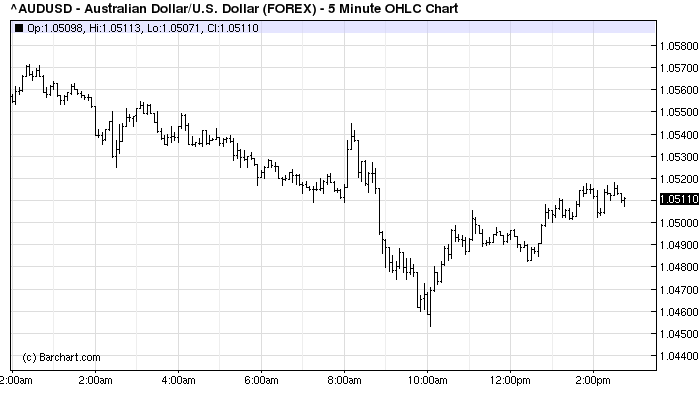There’s a lot of noise today. And yes, it’s threatening to be a “risk off” event. Some typical signs are there. Gold is up. Commodities and the Aussie are down. The euro got monstered. The $US bounced hard.
But it isn’t that simple. Grains are up solidly which is definitely a growth/inflation play and there was a lot of buying support for the Aussie once it fell a one cent:

The S&P too bounced off early lows with buying all day:

These are buy the dip patterns, not run for the hills patterns.
Feels more like a temporary shock to me, brought on by the S&P shift to negative on the US debt outlook. On that, yes it’s a worry, but that’s all, and not particularly now. A nice analysis available at Alphaville shows what little component of US Treasury pricing is a risk premium.
In my view, the real problem with US debt is summed up by Richard Koo, whose notion of a balance sheet recession still makes much more sense than idiot markets demanding austerity. As he points out, if you want to cut the spending of the sovereign whilst the private sector balances its books then growth will fall across the economy, making all debt harder to repay.
Of course, that won’t stop the agencies, nor the markets, so we have probably just entered some new phase in the ongoing great debt unwind that began with the GFC. I just don’t see an imminent calamity. In fact, this austerity pressure in the US can only result in the same outcome as the UK. That is, lower interest rates than otherwise. So markets will get their ongoing growth cycle. Until inflation makes it impossible.
I can’t even get too excited about Europe this morning. It’s more of the same there too, with politics and debt locked in a cliff-top waltz that will teeter but not fall, in my view. It’s clear that Greece is going to default soon, probably in the form of a maturity transformation of its bonds. That is, suddenly they pay back their creditors more slowly. But as Wolfgang Munchau argues today, there’s a million and one little steps ahead for the EU before we start talking serious money. And when we do, they’ll issue a euro bond.
The biggest concern for me about this cycle remains China, where authorities continue to use monetary tightening instead of their currency to address an inflation problem. The more we get into this year, the more I feel like China is headed into a blowoff cycle. That is, every time they raise interest rates they simply draw in more money, not slowing the economy, but heating it up further until some tipping point is reached and voila hard landing.
In the shorter term, however, sovereign ructions do risk converging with another imminent issue that could effect markets: the end of QEII, which the FT confirms today with authority. That’s a real unknown. I’ve been relatively sanguine on it, seeing a lot of underlying momentum in the global recovery now. But a few days of a rising $US will seriously disrupt the sentiment around the reflation dynamic of export-led growth for the US and commodity inflation for everyone else. If it merges with a broader risk-off move, then the downside in this move could grow substantially. The more I think about this, the more it bothers me.
So, all of that adds up to what? No doubt that there could be more downside risk in this move, the $US doesn’t rally 1% in a day for nothing. But the same thing applies as has for the last three years. If you’re a trader, today’s action suggests a buying opportunity on short stops. I wouldn’t bet the house, though. If you’re not a trader, put your money in a 6.5% term deposit.

